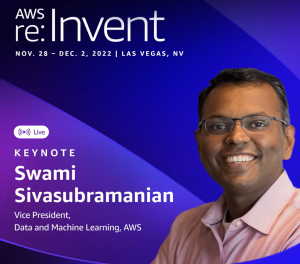
When AWS extrapolated this idea to businesses and the massive amounts of data being produced every day, they saw that there is a tremendous opportunity to absorb, store, process, analyse, and visualise data in order to develop the next big thing.
More than ever before, data serves as the inspiration for cutting-edge innovations. However, developing dynamic, end-to-end data strategies that result in novel consumer experiences is essential if we are to generate novel ideas with our own data. Many of the world’s most well-known companies, including Formula 1, Toyota, and Georgia-Pacific, have already adopted this practice by relying on AWS.
 Swami Sivasubramanian, Vice President of AWS Data and Machine Learning, speaking at AWS re:Invent 2022 this week, revealed numerous critical insights gained by AWS through its collaboration with these companies and the more than 1.5 million customers that use AWS to construct their data strategy.
Swami Sivasubramanian, Vice President of AWS Data and Machine Learning, speaking at AWS re:Invent 2022 this week, revealed numerous critical insights gained by AWS through its collaboration with these companies and the more than 1.5 million customers that use AWS to construct their data strategy.
Swami also unveiled a number of new features and services available to AWS’ extensive client base. Just a handful of the highlights are listed below.
To get the job Done, you Need a Full Range of Services
Building a data lake for analytics and ML purposes is not a comprehensive approach to data management. However, because your requirements will evolve over time, AWS thinks that every customer should have access to a wide range of tools that can be tailored to their data, personas, and use-cases.
This is backed up by data from AWS, which shows that 94% of the top 1,000 AWS customers use more than 10 of their database and analytics services. In the long run, a cookie-cutter strategy fails miserably.
To store and query data in databases, data lakes, and data warehouses; to take action with analytics, business intelligence, and machine-learning; and to organise and control data across your organisation, you need a full suite of services.
Furthermore, you should be able to make use of services that are flexible enough to accommodate a wide range of data types for your future use-cases, whether you’re dealing with retail, medical, or financial information. While many AWS customers are now making use of their data to build ML models, other formats remain too inconvenient to manipulate and prepare for the technology.
Examples include geographical data, which is crucial for applications like autonomous vehicles, city planning, and agricultural yield but can be challenging to acquire, process, and visualise for machine-learning. This week, AWS made it easier for data scientists to work with geographic data by announcing new features for Amazon SageMaker through their Vice President of AWS Data and Machine Learning.
Priority is Given to Efficiency and Safety
All of AWS’s clients continue to place a premium on performance and security as cornerstones of their data strategy.
If you want to swiftly analyse and visualise your data, you will need to be able to perform at scale across all of your data storage locations. Amazon’s success has been founded on the strength of its high-speed services like Amazon Aurora, Amazon DynamoDB, and Amazon Redshift; today, AWS unveiled a number of new features designed to expand upon these advancements in performance.
 Swami Sivasubramanian, Vice President of AWS Data and Machine Learning (Source: AWS)
Swami Sivasubramanian, Vice President of AWS Data and Machine Learning (Source: AWS)
Connecting Data is Essential for More Profound Insights
Integrating disparate data sources into a unified database is essential for producing useful results from your data. To ask new questions about your data or develop new ML models, however, you will need to manually integrate your data sources every time. This is because connecting data across silos often necessitates sophisticated extract, transform, and load (ETL) pipelines. This is not fast enough for today’s businesses.
As time goes on, we will reach a point where we need zero ETL. AWS has been working toward a future with zero data transformation and loading (ETL) by increasing the level of integration between AWS’s various services for quite some time. With the announcement that Aurora now enables zero-ETL connectivity with Amazon Redshift, AWS is one step closer to a future where transactional data in Aurora can be combined with the analytical power of Amazon Redshift.
Additionally, AWS has introduced an auto-copy functionality between Amazon Simple Storage Service (Amazon S3) and Amazon Redshift, eliminating the need to construct and manage ETL pipelines every time you wish to access your data for analytics. And this isn’t the end of it. Connecting to hundreds of data sources, ranging from SaaS apps to on-premises databases, is now possible with AWS.
To make it simple for their clients to examine all of their data, regardless of its location, AWS will continue to incorporate no zero-ETL capabilities into their offerings.
Data Governance Liberates Creativity
In the past, governance was deployed to protect sensitive information by isolating it. However, with the proper governance plan in place, you can move and innovate more quickly by setting up safeguards that ensure the right people have access to your data at the right time and in the right places.
Today, AWS is proud to be releasing new capabilities in Amazon Redshift and Amazon SageMaker to make it simpler for customers to administer access and privileges across more of their data services.
In addition, AWS heard from all of its clients that an end-to-end strategy would be most helpful so that they may exercise control over their data at every stage of its lifecycle. Thus today, AWS introduced Amazon DataZone, a data management solution that facilitates the organisation-wide cataloguing, discovery, analysis, sharing, and governance of data.
When data is correctly and securely managed, it can flow where it needs to go and help teams and departments work together more effectively.
Create With AWS
As you develop your end-to-end data strategy, keep in mind that AWS offers assistance with the new services and features introduced this week, as well as their whole collection of data services. In fact, AWS has an entire staff as well as a vast network of partners to assist with laying the groundwork for data storage that will serve their needs now and in the future.
“Data is inherently dynamic and harnessing it to its full potential requires an end-to-end data strategy that can scale with a customer’s needs and accommodate all types of use-cases – both now and in the future,” said Swami Sivasubramanian.
He continued, “To help customers make the most of their growing volume and variety of data, we are committed to offering the broadest and deepest set of database and analytics services. The new capabilities announced today build on this by making it even easier for customers to query, manage, and scale their data to make faster, data-driven decisions.”




